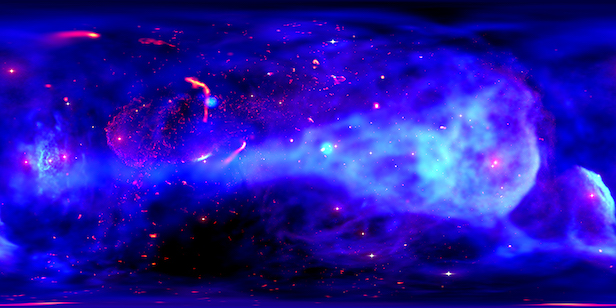View the explosive X-ray scene at the galactic centre
This new visualisation offers a 360 degree, riveting experience of what resides at the centre of our Milky Way

This still image is a single frame from the visualisation that allows viewers to view the centre of our Galaxy as if they were sitting in the position of the Milky Way’s supermassive black hole (Sgr A*). Image credit: NASA/CXC/Pontifical Catholic Univ. of Chile /C.Russell et al.
Want to take a trip to the centre of the Milky Way? Check out a new immersive, ultra-high-definition visualisation. This 360-movie offers an unparalleled opportunity to look around the centre of the galaxy, from the vantage point of the central supermassive black hole, in any direction the user chooses.
By combining NASA Ames supercomputer simulations with data from NASA’s Chandra X-ray Observatory, this visualisation provides a new perspective of what is happening in and around the centre of the Milky Way. It shows the effects of dozens of massive stellar giants with fierce winds blowing off their surfaces in the region a few light years away from the supermassive black hole known as Sagittarius A* (Sgr A* for short).
These winds provide a buffet of material for the supermassive black hole to potentially feed upon. As in a previous visualisation, the viewer can observe dense clumps of material streaming toward Sgr A*. These clumps formed when winds from the massive stars near Sgr A* collide. Along with watching the motion of these clumps, viewers can watch as relatively low-density gas falls toward Sgr A*. In this new visualisation, the blue and cyan colours represent X-ray emission from hot gas, with temperatures of tens of millions of degrees; red shows moderately dense regions of cooler gas, with temperatures of tens of thousands of degrees; and yellow shows of the cooler gas with the highest densities.
A collection of X-ray-emitting gas is seen to move slowly when it is far away from Sgr A*, and then pick up speed and whip around the viewer as it comes inwards. Sometimes clumps of gas will collide with gas ejected by other stars, resulting in a flash of X-rays when the gas is heated up, and then it quickly cools down. Farther away from the viewer, the movie also shows collisions of fast stellar winds producing X-rays. These collisions are thought to provide the dominant source of hot gas that is seen by Chandra.
When an outburst occurs from gas very near the black hole, the ejected gas collides with material flowing away from the massive stars in winds, pushing this material backwards and causing it to glow in X-rays. When the outburst dies down the winds return to normal and the X-rays fade.
The 360-degree video of the Galactic Centre is ideally viewed through virtual reality (VR) goggles, such as Samsung Gear VR or Google Cardboard. The video can also be viewed on smartphones using the YouTube app. Moving the phone around reveals a different portion of the movie, mimicking the effect in the VR goggles. Finally, most browsers on a computer also allow 360-degree videos to be shown on YouTube. To look around, either click and drag the video, or click the direction pad in the corner.
Keep up to date with the latest news in All About Space – available every month for just £4.99. Alternatively you can subscribe here for a fraction of the price!




